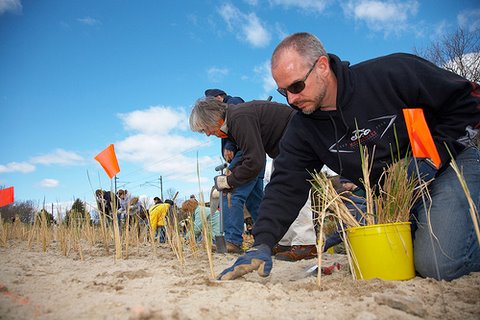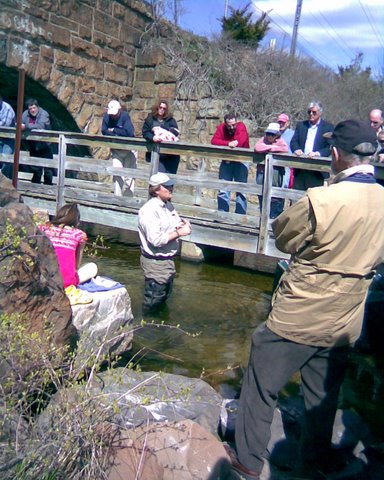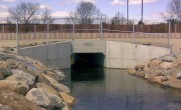Bride Brook Restoration Project
April 19, 2010
PROJECT PARTNERS DEDICATE BRIDE BROOK RESTORATION SITE
Work at Rocky Neck Comes to a Close

Niantic, CT, April 19, 2010—Today, Congressman Joe Courtney, D-2nd District, joined representatives of the National Oceanic and Atmospheric Administration Restoration Center (NOAA), US Department of Agriculture – Natural Resources Conservation Service (NRCS), US Fish and Wildlife Service, FishAmerica Foundation, Restore America’s Estuaries (RAE), the Connecticut Department of Energy and Environmental Protection (DEP), and Connecticut Fund for the Environment (CFE) at the dedication of the Bride Brook restoration project at Rocky Neck State Park.
Don Strait, executive director of Connecticut Fund for the Environment, said, “Our partners and the state’s Congressional delegation are truly remarkable. Not only do they recognize that the benefits of a strong and healthy Long Island Sound are vitally important to both the environment and the regional economy, but they also bring a unique passion and level of education to this community that is inspirational. Finishing this one restoration project is an essential part of reviving a much bigger system, but it also demonstrates what can happen when citizens and government unite for a common purpose, a lesson well-timed for the 40th anniversary of Earth Day.”

“The completion of the Bride Brook restoration project is a great example of the power that partnerships can have. Agencies and organizations, working together, have accomplished a major victory for restoring this critical habitat,” said Jeff Benoit, president and CEO of Restore America’s Estuaries, a national alliance of coastal conservation organizations.
In June 2009, NOAA awarded Save the Sound, a program of CFE, $1.5 million through the American Recovery and Reinvestment Act to support two marsh restoration projects—the Bride Brook culvert replacement at Rocky Neck and the West River tide gate replacement in New Haven. The NOAA funding, in conjunction with funding already in place from NRCS, US Fish and Wildlife, FishAmerica Foundation, CT DEEP, and RAE, made the Rocky Neck project a reality.
“Bride Brook serves as another example of the Federal Recovery Act creating jobs and addressing local needs. After enduring a particularly tough economic period, construction workers will play a central role in rehabilitating these habitats which will benefit the entire community. I applaud Connecticut Fund for the Environment and everyone on the state and federal levels that made this happen in a timely manner,” said Congressman Joe Courtney, D-2nd District.
Working closely with biologists, engineers, restoration ecologists, water resource engineers, and other experts from each of the project partners, the DEP, and Schumack Engineered Construction (Clinton, Conn.), the project went through multiple phases that involved re-routing Bride Brook in order to dig out the old
collapsing and occluded culvert, dropping in the new massive concrete culvert sections, opening a channel to the Sound, and finally, restoring the acres of dune habitat that had been disrupted around the worksite.
Connecticut DEP Deputy Commissioner Susan Frechette said, “The project to repair the culvert in Bride Brook allows for the flow of water that is critical to the health of the tidal marsh and for improved fish passage. Bride Brook is one of the largest alewife migratory runs in Connecticut and restoration of the culvert is essential to assuring that alewives are able to migrate properly into the marsh area to spawn.”
“‘Think globally, but act locally,’ Aldo Leopold instructed us as conservationists. This project is a wonderful and remarkable example of how a partnership can accomplish great things. While this project is nearing its completed restoration—the work is just beginning—to restore thousands of similar sites across Connecticut and many other ecosystems. Thousands of barriers to anadromous species need to be addressed across the state—still. Today, we celebrate this success knowing that much, much more remains to be done,” Douglas L. Zehner, State Conservationist, Natural Resources Conservation Service.
Despite its small size, Bride Brook is a wholly unique estuarine system that hosts the second largest migratory fish run in the state, bested only by the Connecticut River. The work on the culvert finished up in time for the spring herring run, and the new culvert has already had over 40,000 [l1] herring swim through it on their way to Bride Lake to spawn. Experts anticipate 75,000 herring will find their way through the culvert to Bride Lake this spring.
“The Bride Brook restoration project was one of only 50 coastal restoration projects selected for NOAA funding through the Recovery Act,” said Dr. Perry Gayaldo, Deputy Chief of the NOAA Restoration Center. “This was a unique opportunity to restore a tidal marsh and protect and enhance one of Connecticut’s most valuable fish runs, while creating jobs and stimulating the economy.”
“The benefits to fish and wildlife from this project reach far beyond Rocky Neck State Park and the shores of Bride Brook,” said Paul Phifer, Assistant Regional Director for the US Fish and Wildlife Service’s Ecological Services Division. “Egrets and shorebirds will use restored marsh and tidal flats, American eel and shad will pass through here, and saltmarsh sparrows and American black ducks will find greater opportunities for nesting and feeding. Each piece of our environment we restore—like Bride Brook, the lake, the marsh, and the dunes—brings health to the fish, wildlife, and plants which are all part of the web of natural resources we need to exist.”
These projects will have an enormous environmental impact through the restoration of marshland that is home to bird and fish species important to the Long Island Sound ecosystem and will enhance the eight-billion-dollar Sound economy. Herring are an important part of the Sound’s food chain, attracting large fish that in turn bring boaters, fishermen, and tourists to many shoreline communities.
“We are so pleased to be a part of the Bride Brook restoration project. Not only does this project benefit several species of fish including striped bass but it will also improve sportfishing for many of the 300,000 anglers who fish in Connecticut and generate more than $243 million for Connecticut’s economy each year,” said Johanna Laderman, executive director of the FishAmerica Foundation.
The Woods Hole Group, coastal science specialists, was responsible for all of the engineering, design, and hydrology work at Bride Brook.
West River, the second project funded through the Recovery Act, is due to begin within a year. Existing degrading tide gates will be replaced with self-regulating tide gates that will allow water from Long Island Sound to flush the marsh, restore the original ecosystem balance, and allow fish easier passage to breeding grounds.
